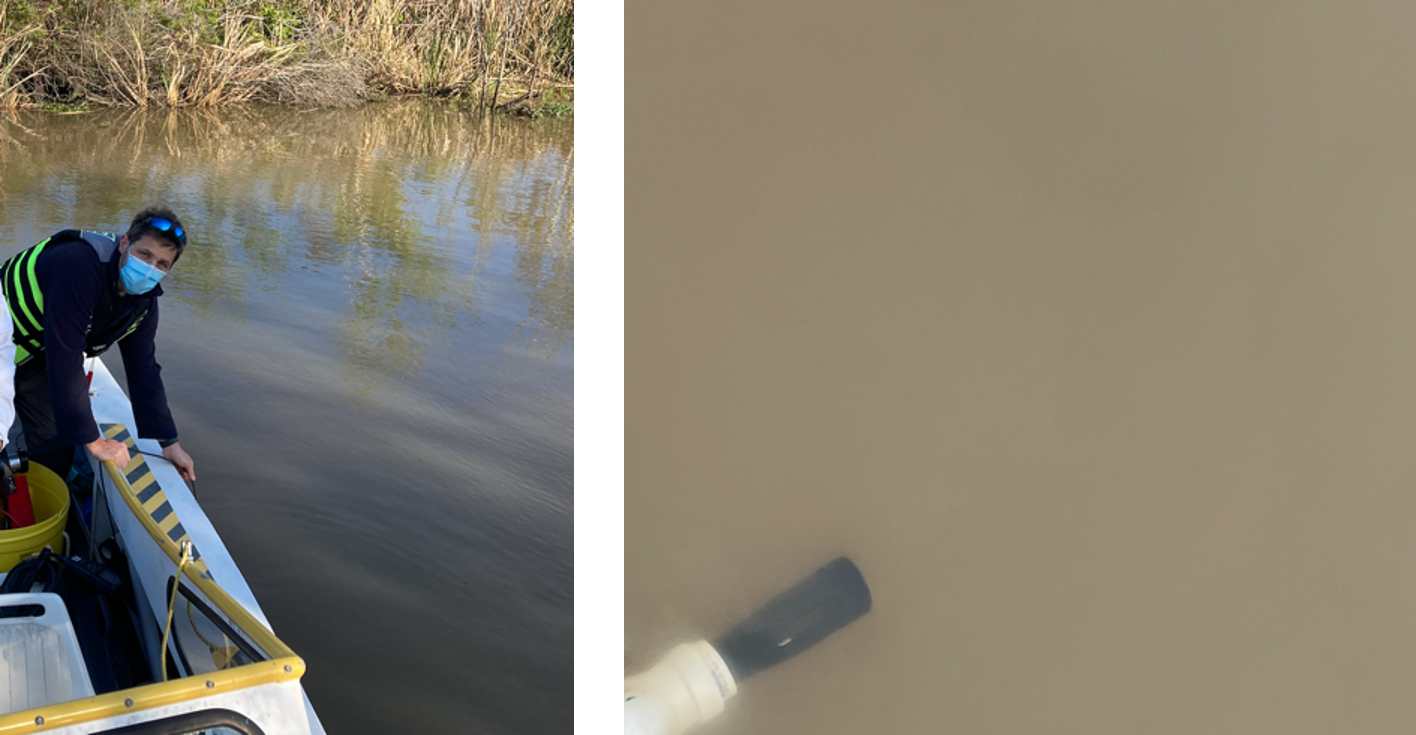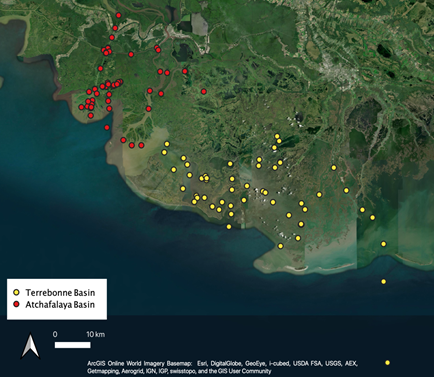Documentation Revision Date: 2021-11-08
Dataset Version: 1
Summary
This dataset includes 1 file in comma-separated values (*.csv) format.
The QA and documentation of this dataset is in progress.

Figure 1: ProDSS probe being deployed by hand off the side of the boat (left), and picture of the probe submerged in the turbid waters of the study area (right).
Citation
Fichot, C.G., J. Harringmeyer, and M. Weiser. 2021. Delta-X: In Situ Water Quality Indicators across MRD, LA, USA, 2021. ORNL DAAC, Oak Ridge, Tennessee, USA. https://doi.org/10.3334/ORNLDAAC/1992
Table of Contents
- Dataset Overview
- Data Characteristics
- Application and Derivation
- Quality Assessment
- Data Acquisition, Materials, and Methods
- Data Access
- References
Dataset Overview
The Delta-X mission is a 5-year NASA Earth Venture Suborbital-3 mission to study the Mississippi River Delta in the United States, which is growing and sinking in different areas. River deltas and their wetlands are drowning as a result of sea level rise and reduced sediment inputs. The Delta-X mission will determine which parts will survive and continue to grow, and which parts will be lost. Delta-X begins with airborne and in situ data acquisition and carries through data analysis, model integration, and validation to predict the extent and spatial patterns of future deltaic land loss or gain.
Data Characteristics
File Naming Convention :
|
DeltaX_WaterQualityIndicators_[CAMPAIGN].csv [CAMPAIGN] refers to the field campaign (e.g., “Spring_2021”) |
Parameters or variables provided in the dataset
|
Variable |
Units of measurement |
Description |
Collected during the Pre-Delta-X campaign? |
|
basin |
N/A |
“Atchafalaya” or “Terrebonne” |
Yes |
|
site_id |
N/A |
Name of site |
No |
|
campaign |
N/A |
e.g. Spring_2021 |
No |
|
latitude |
Decimal degrees |
Latitude of sampling location |
No |
|
longitude |
Decimal degrees |
Longitude of sampling location |
No |
|
date |
YYYY-MM-DD |
Date of sampling and measurement |
No |
|
time |
HH:MM:SS |
UTC time of sampling |
No |
|
depth |
meters |
Depth of sampling |
No |
|
turbidity |
FNU |
average turbidity |
No |
|
standard_deviation_of_turbidity |
FNU |
Standard deviation of turbidity |
No |
|
salinity |
PSU |
average salinity |
No |
|
standard_deviation_of_salinity |
PSU |
Standard deviation of salinity |
No |
|
temperature |
oC |
average temperature |
No |
|
standard_deviation_of_temperature |
oC |
Standard deviation of temperature |
No |
|
chlorophyll_a_fluorescence |
µg L-1 |
average chlorophyll-a fluorescence |
No |
|
standard_deviation_of_chlorophyll_a_fluorescence |
µg L-1 |
Standard deviation of chlorophyll-a fluorescence |
No |
Application and Derivation
During the Delta-X Campaigns, in situ measurements of water temperature (oC), salinity (PSU), turbidity (FNU), chorophyll-a fluorescence (µg L-1) in surface waters were collected at a number of sites across the Atchafalaya and Terrebonne basins. These sites spanned large and small channels at locations chosen to cover a representative range of suspended solids concentration from a variety of hydrodynamic and physical settings typically encountered across the Atchafalaya and Terrebonne basins. This dataset is used to inform and validate Delta-X’s sediment transport models. These measurements made at discrete locations are paired with other measurements of total suspended sediment concentration made on discrete water samples, and are paired with other measurements of in situ beam attenuation coefficient at 670 nm, average suspended particle size, suspended particle size distributions, and in situ and airborne water reflectance (all provided as separate data sets). These location- and time-specific measurements are compared to numerical models to calibrate and validate its parameters. The models quantify the mesoscale (i.e., on the order of 1 ha) patterns of soil accretion that control land loss and gain and predict the resilience of deltaic floodplains under projected relative sea-level rise. Understanding and mitigating the impact of the relative sea-level rise on coastal deltas is urgent. If ignored, relative sea-level rise will very soon have devastating consequences on the livelihood of the half-billion people that live in these low-lying coastal regions.
Quality Assessment
The ProDSS was calibrated for conductivity at the beginning of the campaign and for turbidity every two weeks using the calibration solution recommended and sold by YSI®. The turbidity was calibrated using Milli-Q water (for 0 FNU) and a formazin solution of 124 FNU recommended by YSI, which bracketed the range of turbidity observed in the study area. The chlorophyll-a fluorescence provided here are only calibrated with Milli-Q water in order to zero the instrument. The instrument was pressure-tared on the boat deck before deployment. The instrument was lowered from the side of the boat and the data was collected at the surface for about two minutes at a rate of 1 Hz. The data from the two-minute recording was averaged and a standard deviation of the measurements was calculated.
Data Acquisition, Materials, and Methods
Sampling Procedure
Each in situ measurement was collected directly by lowering the ProDSS water-quality probe from the side of the boat and keeping it submerged at about 0.5 m beneath the surface (Figure 1). Measurements were collected at a rate of 1 Hz for a duration of about two minutes before retrieving the instrument. Data from the ProDSS were then retrieved and exported as individual casts using the commercial YSI® KorDSS software. Each cast was then processed in MATLAB® to generate the products of interest including: water temperature (oC), salinity (PSU), turbidity (FNU), chlorophyll-a fluorescence (µg L-1). In the processing, the measurements collected at the surface for about two minutes were averaged and the standard deviation was calculated.
Study Sites
The Spring 2021 campaign collected measurements from the ProDSS at different locations across the Atchafalaya and Terrebonne Basins (Figure 2). Each sampling site was named using a combination of abbreviations provided in Table 1 as follows: BBB_MMDD_TN where BBB is the abbreviation for the basin (WLD or TB), MMDD is the month and day of 2021 (e.g., 0327 for March 27, 2021), T is the abbreviation for the station type (F for Full station, D for Dry station, and B for Basic station), and N is the sequential number of the station of each type sampled that day (B1 for first basic station, S1 for first full station, S2 for second full station, etc.).

Figure 2: Water-quality indicators measurement sites for the Spring 2021 Delta-X campaign.
Table 1: YSI ProDSS site naming
|
Abbreviated Site name |
Full Site name |
|
WLD |
Atchafalaya Basin (including Wax Lake Delta) |
|
TB |
Terrebonne Basin |
|
S |
Full station (Water samples for TSS was collected along with water reflectance, measurements from the LISST, and water-quality indicators from ProDSS probe) |
|
D |
Dry stations (No Water samples for TSS was collected, but measurements of water reflectance, from the LISST, and water-quality indicators from ProDSS probe were collected) |
|
B |
Basic station (only measurements of LISST, and water-quality indicators from ProDSS probe were collected) |
Data Access
These data are available through the Oak Ridge National Laboratory (ORNL) Distributed Active Archive Center (DAAC).
Delta-X: In Situ Water Quality Indicators across MRD, LA, USA, 2021
Contact for Data Center Access Information:
- E-mail: uso@daac.ornl.gov
- Telephone: +1 (865) 241-3952